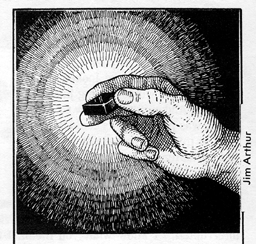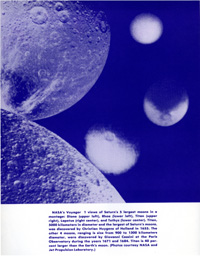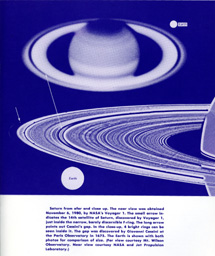Miscellaneous Items
Webpage Table of Contents (Bookmarks)
(Internal links to categories of items in this webpage)
Information About the Publication
(Editorial Board, Editors, Table of Contents)

Editors, and Others Involved in the Publication
Editor: John Kraus, Director, Ohio State University Radio Observatory.
Co-Editor: Robert S. Dixon, Assistant Director, Ohio State University Radio Observatory
Assistants: Alice Kraus, Amahl Drake, Pene Curmode, Hazel Snyder
Staff Artist: Jim Arthur
Editorial Board
- Richard Berendzen, President, The American University
- John Billingham, Director SETI Program, NASA-AMES Research Center
- Ronald Bracewell, Director, Radio Astronomy Observatory, Stanford University
- Arthur C. Clarke, Sri Lanka, author of "2001, A Space Odyssey"
- Norman Cousins, Chairman, Editorial Board, SATURDAY REVIEW
- Frank D. Drake, Director, National Astronomy and Ionosphere Center (Arecibo), Cornell University
- Donald S. Hall, Director, Strasenburgh Planetarium, Rochester, New York; Past President, International Planetarium Society
- Theodore M. Hesburgh, President, University of Notre Dame
- Nikolai Kardashev, Space Research Institute, Academy of Sciences, Moscow, USSR
- Philip Morrison, Physics Department, Massachusetts Institute of Technology
- Bernard Oliver, Vice President, Hewlett-Packard Company; Director of NASA-Ames Cyclops Project
- Cyril Ponnamperuma, Director, Laboratory of Chemical Evolution, University of Maryland
- Martin Rees, Director, Institute of Astronomy, Cambridge University, England
- Carl Sagan, Director, Laboratory for Planetary Studies, Cornell University
- Walter Sullivan, Science Editor, New York Times
- Vasevolod R. Troitsky, Radiophysical Scientific Research Institute, Gorky, USSR
- Sebastian von Hoerner, National Radio Astronomy Observatory
About COSMIC SEARCH
COSMIC SEARCH is published quarterly (Winter, Spring, Summer, Fall) by Cosmic-Quest, Inc. Copyright © 1980 by Cosmic-Quest, Inc. All rights reserved. Cosmic Quest, Inc., is a non-profit educational-scientific organization.
Opinions expressed by persons writing in COSMIC SEARCH are their own and do not necessarily reflect the opinions of the editorial staff.
Subscription price: $10 for 4 issues in U.S. (and possessions), $13 elsewhere. Single copies: $2.50 in U.S. (and possessions), $3 elsewhere.
Address subscriptions and all other correspondence to: Radio Observatory, Box 293, Delaware, Ohio 43015.
Second-class postage is paid at Delaware, Ohio, and at additional mailing offices.
Note to subscribers: The last digits of the top line of your address label indicate the last issue of your subscription.
The name COSMIC SEARCH is a registered trademark.
Front Cover
The Space Telescope (Photo courtesy NASA). See page 18 (the article entitled "People").
Table of Contents (in magazine)
| Contents | Pg |
|---|
Space Travel and Life Beyond the Earth
by E.J. Öpik | 2 |
|---|
On Intelligence: A Wave of the Past and Future
by Frank D. Drake | 5 |
|---|
What Makes Atoms Tick?
by Earle Holland
| 6 |
|---|
The Next Best Thing to Being There
by William R. Dodson | 10 |
|---|
The Nature of Extraterrestrial Communication
by Robert E. Kuttner | 20 |
|---|
Intra-terrestrial Intelligence
by W.A. Rhodes | 22 |
|---|
| Features | |
|---|
| Editorial | 24 |
|---|
| College Courses | 9 |
|---|
| Puzzle | 12 |
|---|
| Donors | 12 |
|---|
| The Sentinel | 13 |
|---|
| ABCs of Space | 14 |
|---|
| People | 18 |
|---|
| In Search of Planets | 19 |
|---|
| Perpetual Index | 8 |
|---|
| In Review | 17 |
|---|
| Order Blank | 9 |
|---|
| Letters | 12 |
|---|
Photo Credits:
Henrietta Leavitt (Shopley, Harlow, "Through Rugged Ways to the Stars," N.Y., Charles Scribner's Sons, 1969). Harlow Shapley (American Institute of Physics. Niels Bohr Library. Shopley Collection).
THANK YOU!
COSMIC SEARCH expresses sincere thanks to the following donors who are helping to make sure that the story of SETI and mankind's future continue to be told in an interesting and factual way.
Planetary Donors
Robert J. Allen, Blythdale, Missouri
George Austin, M.D., Loma Linda, Cal.
Jane L. Brooks, Adelaide, S. Australia
Vera Buescher, Mountain View, Cal.
Jack Craig, Oregon City, Oregon
William E. Dorion, McLean, Virginia
Amahl S. Drake, Ithaca, New York
Harry Duke, Los Altos, Cal.
Nancy F. Eberbach, Ann Arbor, Mich.
Hale P. Faris, San Jose, Cal.
B. Fredricksen, White Bear Lake, Minn.
Richard and Maria Gauthier, North Bay, Ontario
Paul J. Hurn, Seven Mile, Ohio
James C. Killman, Sherman, Texas
David M. Laida, Sierra Vista, Arizona
Nelson Lecklikner, Novata, Cal.
John L. Mohr, San Antonio, Texas
Arthur J. Morgan, New York, N. Y.
A. V. Shaver, Winchester, Virginia
Paul Simmons, Sheboygan, Wis.
Eric W. Six, Iowa City, Iowa
John B. Theiss, Tucson, Arizona
Dennis Wildfogel, Pomona, N.J.
One Anonymous
Stellar Donors
Keith Conrad, Toledo, Ohio
George L. Douglass, II, Reno, Nev.
John Fadum, Boca Raton, Florida
David C. Halley, Colonial Hts., Vir.
Virginia Shaver, Winchester, Vir.
Paul Simmons, Sheboygan, Wis.
John Teetor, Marion, Ohio
C.L. Turnage, Camarillo, California
Cosmic Donors
Two anonymous
COSMIC SEARCH, published by a non-profit scientific-educational organization, has been granted tax-exempt status by the Internal Revenue Service, so contributions are tax-deductible (but subscriptions are not). On a combination donation-subscription or donation-renewal, the amount over and above the magazine cost is tax deductible. For example, if a donor sends $30 (qualifying as a "Planetary Donor") and includes a two-year subscription at $18, the $12 difference is tax-deductible.
Donation categories are as follows:
Planetary: $30 per year
Stellar: $100 per year
Galactic: $500 per year
Cosmic: $1000 per year
Contributions, however, will be gratefully accepted in any amount. Checks should be made payable to Cosmic Quest, Inc., P.O. Box 293, Delaware, Ohio 43015.
COSMIC SEARCH AWARDS
For best papers on SETI
Category 1. Undergraduate students
Category 2. Graduate students
Category 3. Anyone else under 30 years of age
Papers may be on any aspect of the Search for Extra-Terrestrial Intelligence (SETI). Papers must be double-spaced typewritten with one inch margins on 81/z by 11 inch bond paper and less than 2000 words in length. Any illustrations must be clearly executed.
Authors of best papers will be given a COSMIC SEARCH AWARD of $100 and the paper will be published in COSMIC SEARCH. Authors should include their full address and telephone number. Authors should enclose a self-addressed stamped envelope if they wish to have their manuscripts returned.
Manuscripts may be submitted at any time. Their review is a continuous, on-going process. Each article received is reviewed by a special committee and if judged worthy, either in its original form or after revisions, will be given a COSMIC SEARCH AWARD. The opinion of the committee is final.
A contestant may submit and have under review only one manuscript at a time and be eligible for only one COSMIC SEARCH AWARD in one category. However, it is possible for one person to achieve COSMIC SEARCH AWARDS sequentially in each
of the three categories.
Address COSMIC SEARCH AWARD Committee, Radio Observatory, P.O. Box 293, Delaware, Ohio
43015.
A Message to Humanity
A puzzle for computer buffs
[This puzzle was found on page 12 in the magazine, with hints found on page 21 and the answers found on page 24. Try to solve this puzzle without looking at the Hints and the Answers found here immediately below the puzzle.]

Suppose a friendly extraterrestrial presents us with a message to humanity in the form of a 20-gram piece of carborundum (silicon carbide). It looks like a palm-sized version of the monolith from "2001." The message is encoded in the lattice of the crystal; each carbon atom represents a zero, each silicon atom a one. The number 2001, for example, is represented by the
sequence SiSiSiSiSiCSiCCCSi.
From the above data calculate:
(1) the number of bits of information in the message,
(2) the time necessary to read the message if it can be read at 10 megabits per second,
(3) the number of computer tapes necessary to store the message if each tape is 730 meters long and stores 1600 bytes per inch (8 bits = 1 byte), and
(4) the cost of these tapes if each one is $25.
This problem is from John Ball, a radio astronomer at the Harvard-Smithsonian Center for Astrophysics in Cambridge, Massachusetts. Some hints are on page 21. [See immediately below, but DON'T LOOK!
A Message to Humanity — Hints
These are hints to help solve the problem on page 12. A gram-mole of any substance contains Avogadro's number (6.0225 x 1023) of molecules. The molecular weight of silicon is 28.086, and of carbon 12.011; so the molecular weight of silicon carbide is 40.097. Thus 40.097 grams of silicon carbide contain Avogadro's number of molecules. But the prescription in the problem records two bits in each molecule.
The answers are on page 24. [See immediately below, but again DON'T LOOK!
A Message to Humanity — Answers
These are answers to the problem on page 12. (1) 6 x 1023 bits. (2) 1.9 x 109
years (That is almost half the age of
Earth.) (3) 1.6 x 1015 tapes (That is
about 400,000 tapes for each person on
Earth.) (4) $40,000,000,000,000,000.
Miscellaneous Photos
The following photos (found on the inside front cover and inside back cover) are not directly associated with any article.
Inside Front Cover Photo

Inside Back Cover Photo

|
![[NAAPO Logo]](../../Images/NAAPOsm.jpg)
![[NAAPO Logo]](../../Images/NAAPOsm.jpg)